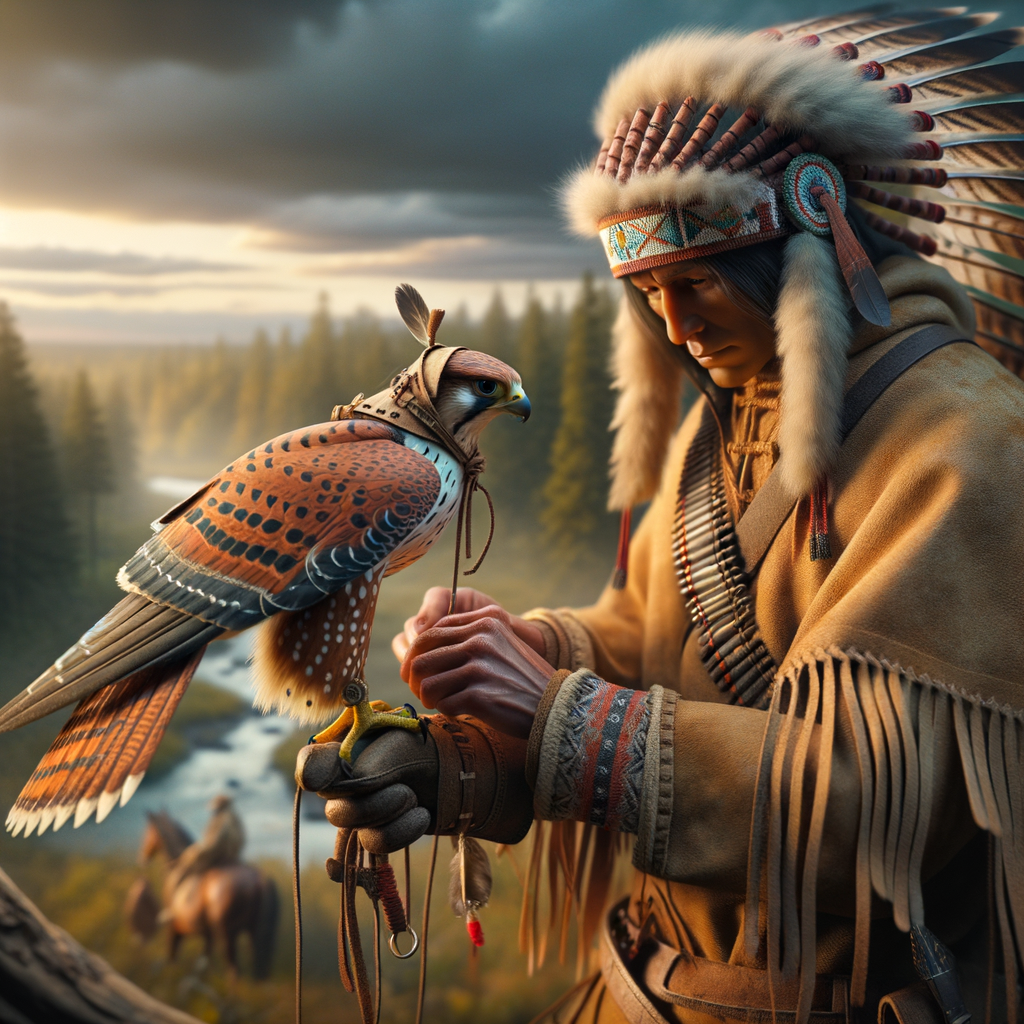The Role of Falconry in Maintaining Ecosystem Balance
- Understanding Falconry: Falconry is the ancient art of hunting with birds of prey, such as falcons, hawks, and eagles.
- Importance of Birds of Prey: These birds are crucial in controlling the population of small mammals, birds, and insects.
- Ecosystem Balance: By keeping these populations in check, birds of prey help maintain a healthy and balanced ecosystem.
- Habitat Conservation: Falconers often participate in conservation efforts, helping to protect natural habitats and the biodiversity within them.
- Education and Awareness: Practicing falconry raises awareness about the importance of wildlife conservation and the role of predators in nature.
- Biodiversity Support: Healthy predator populations contribute to the overall diversity and resilience of ecosystems.
- Sustainable Practices: Falconers promote sustainable hunting practices, ensuring that the natural balance is preserved for future generations.
- Community Involvement: Falconry can bring communities together, fostering a sense of connection to nature and shared responsibility for environmental stewardship.
Discovering Falconry’s Role in Ecosystem Balance: An Irish Tale
Picture this: we’re in the heart of the lush Irish countryside, surrounded by emerald-green fields and ancient stone walls. Imagine a delicate dance, where every creature, big or small, has a part to play in keeping the magical balance of nature. Just as in this vibrant Irish tapestry, falconry plays a crucial role in our ecosystem, weaving a story of harmony between humans, birds of prey, and the environment.
At Learn Falconry, we’re passionate about more than just the ancient art of handling these majestic birds. We believe that understanding falconry’s role in maintaining the balance of our ecosystems can help protect and preserve our natural world. In this article, we’re going to take you on a journey through the fascinating connections between falconry and ecosystem balance. You’ll learn why these incredible birds are not just fantastic hunters, but vital guardians of our environment.
Trust us, this isn’t just another nature tale. Just like an Irish jig that lures you to join in, you won’t want to miss the rest of the story. So, get comfortable and keep readingâyouâre about to uncover the intricate ways in which falconry helps maintain the delicate balance of our world, and why this matters more than ever.
The Role of Falconry in Maintaining Ecosystem Balance
Did you know that falconry has a significant impact on maintaining ecosystem balance? Falconry, the art of training falcons to hunt wild game, is not just a thrilling sport; it plays a crucial role in preserving ecological balance. Let’s dive deeper into how falconry contributes to the health of our environment and why it’s essential for maintaining ecosystem balance.
Falconry ecosystem impact is vast and varied. Falcons and other birds of prey help control the population of pest species, ensuring that no single species dominates the environment. This balance prevents overpopulation and the negative effects it can have on crops, other wildlife, and the overall health of ecosystems. By keeping the numbers of small mammals, insects, and other potential pests in check, falconry contributes directly to ecosystem stability.
Moreover, falconry promotes natural hunting behaviors. Falcons that are involved in falconry practices are trained to hunt specific prey, which mimic their natural hunting activities. This not only upholds the natural predatory-prey relationships but also helps in the recovery and maintenance of healthy wildlife populations. Training falcons involves specialized techniques to prepare them for hunting in diverse environments, promoting their fitness and survival abilities in the wild. To learn more about training techniques, check out our guide on basic training techniques for falcons.
Falconry ecological balance also extends to conservation efforts. Many falconers participate in breeding programs aimed at increasing the population of endangered species. These programs are vital for the conservation of various raptors. Breeders carefully manage these programs to ensure genetic diversity and the health of the birds. The reintroduction of bred falcons into their natural habitats supports population stability and genetic health. More information on breeding programs can be found on our page about falconry breeding programs.
Another positive aspect is the habitat protection and restoration efforts driven by falconry. Falconers often work alongside conservationists to protect and restore habitats, ensuring that falcons and other wildlife have safe, natural environments to thrive in. This collaboration includes activities like planting native vegetation, removing invasive species, and monitoring wildlife populations. Our section on habitat restoration and its impact through falconry covers more details on these initiatives.
Finally, falconry is an educational tool that raises awareness about wildlife conservation and the importance of ecosystem balance. Falconry demonstrations and educational programs can inspire people to support conservation efforts and understand the intricate connections within ecosystems. These programs teach the public about the significance of raptors in nature, encouraging more sustainable living practices. Dive deeper into how falconry is used in educational efforts by visiting our page on falconry education programs.
In conclusion, falconry plays a vital role in maintaining ecosystem balance. From controlling pest populations and promoting natural predatory behaviors to supporting breeding programs and conservation efforts, the impact of falconry on ecological balance is profound. By understanding and supporting falconry practices, we can contribute to a healthier and more balanced environment. For more extensive information on how falconry aids in conservation, explore our section on falconry and conservation.
Learn more about the fascinating history of falconry, its modern practices, and the techniques used by visiting our detailed sections on various aspects of falconry:
The Impact of Falconry on Ecosystem Balance
Falconry, a traditional hunting method, significantly impacts ecosystem balance. Below are the focuses on falconry and its effects on the environment in 2024.
Falconry and Ecosystem Balance
Falconry helps maintain ecosystem stability by regulating prey populations. For example, the saker falcon, an apex predator in arid steppe regions, plays a crucial role in balancing its ecosystem. When predator populations like falcons control the numbers of their prey, it indirectly influences vegetation and other species.
Here’s a basic example to illustrate this process:
| Predator | Prey | Vegetation Impact |
|---|---|---|
| Falcon | Rodents | Less vegetation damage due to controlled rodent population |
Conservation Efforts in Falconry
Falconry has both positive and negative implications for conservation. On the one hand, it helps control prey populations, but on the other hand, capturing and removing wild falcons can disrupt local populations. One notable conservation effort highlights the positive side: the introduction of artificial Saker nests in Mongolia led to the breeding of over 3,000 chicks, showcasing falconry’s potential in aiding species preservation.
| Conservation Effort | Result |
|---|---|
| Artificial Saker nests in Mongolia | Breeding of over 3,000 chicks |
Habitat Preservation and Loss
Habitat loss remains one of the most significant threats to bird species, including falcons. Protecting nesting areas and restoring habitats are essential for maintaining healthy populations and ensuring ecological balance.
Climate Change and Falconry
Climate change dramatically impacts falcon populations by altering their habitats and the availability of their prey. Understanding these effects is crucial for developing conservation strategies to protect these birds. Climate change can lead to shifts in where falcons and their prey live, which in turn affects hunting practices and falconry.
Human-Falcon Interactions
Human-falcon interactions, like falconry, can significantly impact local populations. For example, while falconry helps manage prey populations, releasing falcons into the wild without proper genetic testing can introduce unknown hybrid genes, potentially harming the local gene pool.
| Interaction Type | Potential Impact |
|---|---|
| Falconry practices | Managing prey populations positively |
| Release without testing | Risk of hybridization and genetic disruption |
In 2024, the intersection between falconry practices, ecosystem balance, and human intervention showcases a complex and dynamic interaction requiring careful management to maintain long-term ecological health.
The Role of Falconry in Ecological Balance
Falconry, an ancient practice, continues to be significant in maintaining the balance of our ecosystems. By controlling prey populations, falcons help regulate the food chain and contribute to the health of various species and vegetation. However, responsible falconry practices are critical to ensure this positive impact. Conservation efforts are essential, as habitat preservation and careful monitoring of falcon populations help protect these majestic birds from threats like habitat loss and climate change.
Let’s remember that while human-falcon interactions can be beneficial, they must be managed thoughtfully to sustain the ecological balance. As we move forward, embracing and respecting the intricate relationship between falcons and their environments is key. With the right conservation strategies in place, falconry can continue to contribute positively to our world’s ecosystems.
Common Questions About Falconry and Ecosystem Balance
-
How Does Falconry Help Maintain Ecosystem Balance?
Falconry plays a crucial role in maintaining ecosystem balance by using trained falcons to keep certain animal populations in check. For instance, a trained falcon can help control populations of pest birds that might otherwise damage crops. Find out more about the techniques involved by visiting here. -
Are Falcons Used in Falconry Different From Wild Falcons?
Many of the falcons used in falconry are actually wild birds that have been trained. The training process teaches these magnificent raptors to work alongside humans, enhancing their natural hunting skills. You can learn more about different species of falcons used in falconry here. -
Is Falconry Ethical and Environmentally Friendly?
Yes, falconry is both ethical and environmentally friendly when practiced responsibly. Ethical falconry ensures the well-being of the falcons and protects the environment. It involves following legal regulations and guidelines, which you can read more about here. -
What Role Does Falconry Play in Conservation?
Falconry is important for conservation as it often involves the breeding and reintroduction of endangered bird species into the wild. This helps preserve biodiversity. Learn more about these conservation efforts here. -
How Does Falconry Impact Biodiversity?
Falconry positively impacts biodiversity by helping to manage wildlife populations and habitats. Properly trained falcons can assist in studies and monitoring of various species, contributing to ecosystem health. Discover more about its impact on biodiversity here. -
Can Anyone Practice Falconry?
Falconry is not just a hobby; it’s a regulated practice that requires proper knowledge and licensing. To start, one must meet specific legal requirements and often seek guidance from experienced falconers. Check out the essential steps here.



